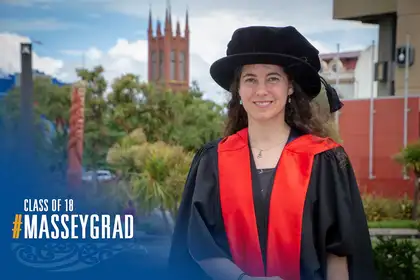
Dr Angela Parody-Merino.
From the south of Spain to the heart of the Manawatū, Dr Angela Parody-Merino has come half-way across the world to study “the superheroes of birds” for her doctoral degree.
Receiving her degree as part of graduation celebrations in Palmerston North earlier this month, Dr Parody-Merino has devoted years of her life studying the New Zealand Godwit or kuaka, a bird which flies non-stop from Alaska to New Zealand, a journey of more than ten thousand kilometres.
The preparation and execution of such a journey has been the focus of many researchers, however Dr Parody-Merino was focused on another aspect.
“My study focused on a specific behaviour: migratory timing behaviour. All organisms in this planet, including us, are governed by rhythms, and there are still many things we don't know about how these occur,” Dr Parody-Merino says. “Individual godwits depart about the same day every year, while the species leaves in a span-time of a month,” This means that individuals seem to have a preference in their departure date for migration with birds preferring to depart always earlier and birds preferring to depart always later. How do they do this? How do they know when to depart?
“Experimental investigations have demonstrated that migratory behaviour has a strong genetic basis, which means that somehow migratory birds receive an internal message telling them that this is the time for you to go! However, we still don't know which are actually those genes triggering this migratory clock.”
The research involved the migratory departure dates of 269 birds recorded for between one to ten years. Dr Parody-Merino obtained blood samples from all these birds and extracted their DNA, and selected 140 candidate genes from scientific literature, which are genes potentially associated to this migratory timing behaviour.
“Simply said, what I did was comparing the DNA sequence of candidate genes of the ‘earlier-departers’ with the DNA sequence of candidate genes of the ‘later-departers’ and see in what they differ. My research has contributed to learn more about how genes shape behaviour in natural populations and more specifically to discover how these amazing birds are capable of accurately time their migration program.”
“There are still many mysteries in how DNA intervene in many aspects, for example in determining behaviours. My research is about that but much more specific: using an extraordinary and wild species as godwits are - this is quite new since most of studies have been done in model animals, not in free living species.”
The main conclusion of Dr Parody-Merino thesis is that the genetic basis of migratory departure date in godwits is more complex than initially anticipated, with possibly a large number of genes being involved in determining it. Dr Parody-Merino has identified those genes and her thesis open new questions regarding the mechanism by which those genes could determine individual’s migratory timing preferences and how other non-genetic factors, such as the photoperiod, could also influence individuals’ migratory departure date.
She is positive that advances in molecular technology and human creativity – and persistency – would be the ingredients that surely allow Science to overcome the difficulty imposed by the complexity of understanding the link between behaviour and genetics.
Getting to New Zealand
Having lived in France, Germany, Ecuador, Uruguay and New Zealand, as well as visiting many more, you might call Dr Parody-Merino a citizen of the world.
“My interest for biology comes from when I was a child. During my summers in my mother's little town I was very connected to nature since I was surrounded by nature. My mother was of great influence because I remember she used to explain things about the flora during walks in the countryside as my mother studied agronomy and then specialized on plants and gardening.
"I remember I use to like watching the birds coming to the garden of the house, and I remember making a list of all the species I could see as an early teenager.”
But like all passions, Dr Parody-Merino’s was fuelled by a passionate teacher.
“During the two years of preparation to university, called ‘Bachillerato’, I had a very good biology teacher, and his classes encouraged me even more to do biology. During these two years of preparation for the university, between 1999-2001, I remember watching several documentaries at the TV about human genome (this was the time of the human genome being almost sequenced if I am right). I was amazed about genetics and to me genetics was the answer for the biodiversity in the planet and the origin of life: I was absolutely amazed and I definitely wanted to learn more, so I decided I wanted to be a biologist and specialize on genetics and ecology.”
“It is funny but I remember in my university it was common between biology students to ask if you were "de bata o de bota", that means "of lab coat or boot", meaning if you were more a biologist-ecologist (more wearing boots to go to the nature) or biologist-molecular/chemistry (more wearing a lab coat and in the laboratory). I used to answer both!”
While Dr Parody-Merino is finishing some chapters from her PhD for publishing and searching for the next job, she is volunteering as a visitor host at the Wildbase Recovery Center of Palmerston north.
“I would like to keep contributing to Science in the fields of genetics/genomics, ecology and, if possible, conservation of bird species. My goals would be to still contributing to Science and at the same time keep learning about genetics/genomics, ecology, conservation and bioinformatics.”